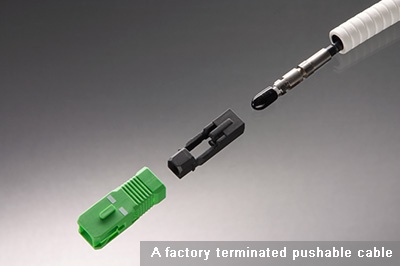 PPC has been producing and selling Miniflex cable and pre-terminated QuikPush fiber to the home (FTTH) drop cable for the last 10 years.
PPC has been producing and selling Miniflex cable and pre-terminated QuikPush fiber to the home (FTTH) drop cable for the last 10 years.
Our vision has always been to remove the inefficiencies of blowing and splicing, to speed up the last drop in FTTH deployments that are carried out by non-fiber specialist installers.
Historically, our focus was on providing our customers with overall cost savings by reducing installation labor time.
However, over the last 36 months we have seen a major change in focus throughout the FTTH global market. We are finding that, while labor time is still important, there is a greater market drive towards enabling non-fiber skilled labor to install the last FTTH drop.
This trend isn’t just happening in emerging markets where labor is relatively cheap, but not necessarily "fiber skilled", but also across the United States and within Europe.
I thought it would be worthwhile to share my thoughts on why I think we have seen this change in market behavior, and how it marks a major step forward in the importance of FTTH as a technology.
The small scale beginnings of FTTH
Until quite recently, with only some notable national exceptions, FTTH deployments were on a small scale. Most installations were viewed as trials, usually consisting of a small number of premises or blocks. Typically, these rollouts utilized the network companies’ highly skilled backbone fiber teams. After all, if a network operator was trialing a fiber network, it made sense to utilize the existing fiber experts.
This meant that while our solutions saved the time of this expensive labor (by reducing splicing and blowing, for example) - these savings were rarely realized due to the fact that rollouts were carried out by skilled, specialized labor.
Furthermore, for valid historical reasons, the majority of backbone fiber engineers have a very splicing and fiber blowing-centric mindset. In a fiber backbone network, this is a rational approach. In any electrical or fiber network, it is the interfaces and connectors, not the physical cables, that are vulnerable to issues. Every connector or splice adds additional attenuation losses and signal dispersion, which reduces the overall distance a signal can be transmitted and, in turn, reduces the overall bandwidth of the signal.
Additionally, the distances involved with fiber backbones tend to be measured in kilometers or thousands of feet. With such long distances, fiber blowing is the only real viable method.
So, FTTH trials typically had no lack of skilled labor and utilized the backhaul installation methodologies of splicing and blowing. When this was combined with material component costs being managed separately from network operational expenditure, it is no wonder that operators tended to use a combination of traditional and lowest material cost solutions.
Therefore, with the growing size of FTTH rollouts, these same network operators are unsurprisingly finding that their trials really didn’t replicate the real world challenges that they are facing today.
In our experience, only forward-thinking companies where both network capital and operational costs were managed together truly bought into the "Miniflex" way.
Times are a-changing
Now FTTH is moving from being something that is trialed to the mainstream, leading to a change of focus. According to Heavy Reading, FTTH subscriber numbers in Europe will double by 2019, representing around 19 per cent of homes in the region. It is a similar picture in other geographies.
We are now seeing three basic types of companies rolling out FTTH:
1. Traditional telecoms operator
As mentioned above, these companies have a cadre of highly skilled and experienced fiber optic engineers - typically with backhaul/backbone experience. However, they are finding that the methodology used for backbone fiber installation just does not work economically for the thousands or millions of homes that now need to be connected.
2. Cable TV companies (MSOs)
These organizations have a large base of home installation engineers, who are experienced in efficient last drop installs. However, they have a coax cable skill-set and the companies don’t have the budget or resources to retrain the workforce to become fiber blowing and splicing experts. So, they want a fiber product that behaves just like coax cable.
3. New incumbents
In the US and Europe, these are typically local co-operatives/municipalities or specialist challengers, but in emerging countries they can be multi-national companies. They all want to rollout an FTTH network. However, while they have experienced network architects and ample access to labor, these crews have a low fiber-skill base, and little installation equipment or experience.
I could argue that Google Fiber is a quasi-combination of all the above.
All of these companies have the same issues. There just isn’t a sufficient number of fiber-skilled staff to roll out a large FTTH network, either economically or in a timely fashion, using the previous fiber backhaul methodologies. Even where network operators have a strong team of skilled installation engineers - such as with MSOs - these typically do not have fiber specific skills.
Therefore, as FTTH accelerates beyond pilots and into city, country or even multi-countrywide rollouts, we are seeing this original model and approach change.
 Meeting the challenges of major installations
Meeting the challenges of major installations
So how is the broadband industry addressing these resource issues? I’m seeing four approaches, often used in combination:
1. Changing the fiber thinking from backbone to the last drop
The final fiber connection to a property is a different challenge to installing a fiber backbone and requires a different approach and equipment. The traditional backhaul concerns of fiber connector attenuation losses and reliability - when transmitting several thousand users’ data at 1Tbps over tens of miles between repeaters - are being found to be not so valid when transmitting a single user’s data the 100-1000ft or so from the cabinet to the home.
2. Make FTTH installation fast and simple
The sheer scale of FTTH projects requires time, specialized skills and specialized equipment to be removed from both cable installation and the physical connection. Operators have been compelled to simplify installation by using pre-terminated cables and simple installation methodologies of direct buried/hanging, pushing and pulling.
Traditionally, the pre-termination of FTTH cable was resisted for three reasons. Firstly, the requirement of storing excess cable lengths. These typically required the use of small excess length storage boxes, which added to the material costs of the installation. Secondly, excess cable was deemed as "wasted" cable - again adding to the material costs and, finally, the bandwidth loss of using connectors is greater than with splicing.
Now, operators are finding that saving the $5 or so material cost around managing excess fiber simply doesn’t compare to the revenue increases of installing more homes, faster.
As mentioned above, the attenuation and bandwidth losses of a connectorized drop solution is completely acceptable in a single user context. Overall, this means that operators are finding that the costs and inefficiencies imposed by blown duct and cable solutions are not economic when only installing short distances.
3. Make installation reliable
The real world of high volume FTTH deployments, often utilizing third party installation companies, requires fiber products that are not only robust but are also easy to handle by non-fiber skilled teams. Many municipal fiber networks in the US, for example, use their own electricians to install networks, in order to lower costs. So operators are looking for products that won’t get damaged or break when being installed by non-specialists.
Operators are also looking for single robust cable solutions that can be installed by a multitude of installation methods - blowing, pushing, pulled, direct buried or simply "P" clipping on an external wall and inside the building.
Finally, the combination of the fragility of blown fiber construction and the (shall we say) robust handling requirements of fast working, non-fiber engineers have compelled operators to move to strong, simple, hand pushing/pulling products and direct buried/hung cable solutions.
4. Look at the overall cost of the implementation for the long term
Without naming names, I can state that every network operator that I have come across, which has had un-coordinated capital expenditure and installation expenditure teams, has found FTTH implementation to be uneconomic - usually combined with wholescale reliability issues, missed installation targets, and out of control deployment costs.
Network operators are learning from (often painful) experience that the products bought and the installation methodologies used are inexorably linked to the reliability and economic success of their FTTH rollouts.
We have found these four mindset changes are valid in all the regions we deal with. In reality, the actual cost of labor doesn’t come into the equation. Every region is facing the same challenge: "how can we roll-out a FTTH network with the resources available" - and most network operators are coming to the same conclusion that they need to change how they operate.
Over the past 36 months, PPC has seen multiple companies in all the markets we sell in go through this journey. Where we lost bids three years ago, we are finding that the very same companies have quietly come back and are now using our solutions.
It may have taken some time, but FTTH is finally moving to the mainstream and growth continues to accelerate around the world. This will further increase the pressure on skilled labor, meaning that now is the time to look at pushable, pre-terminated cable for last drop implementations if you are to enable economically large scale fiber implementations.


